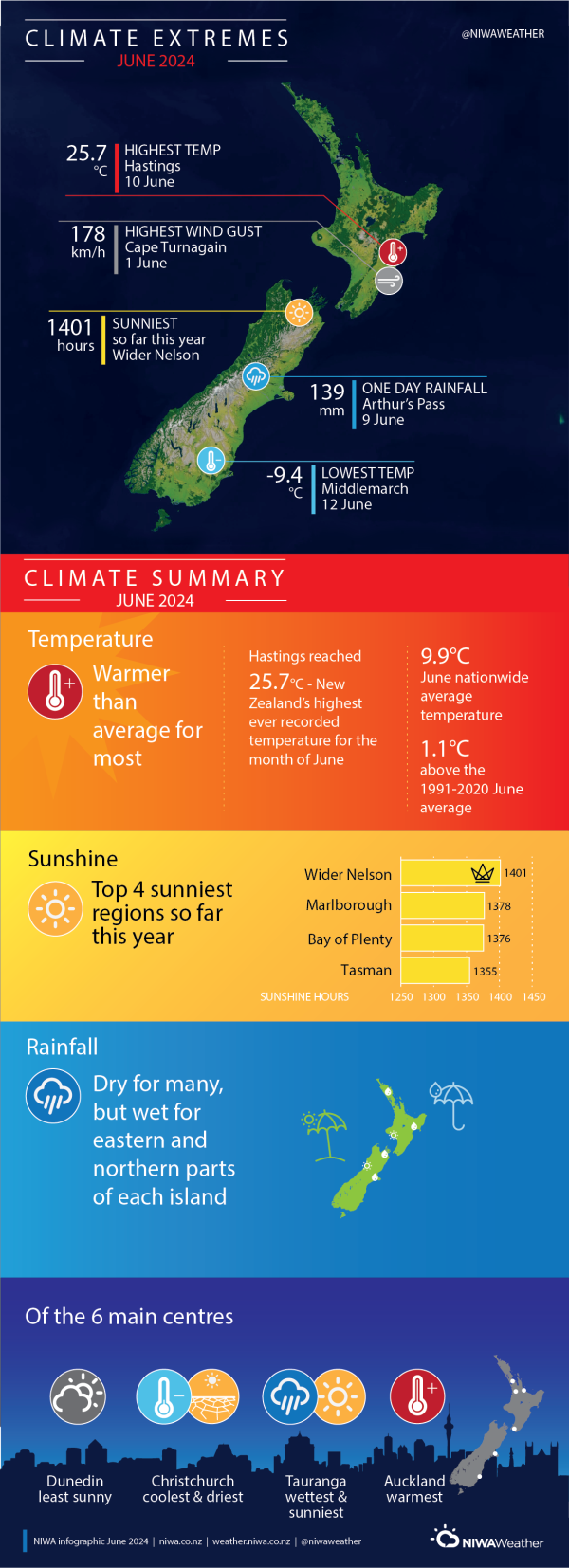Overview
June 2024 mean sea level air pressure was higher than normal to the south and east of the South Island and lower than normal to the west of Aotearoa New Zealand. This was associated with more northeasterly winds than normal for the month overall, which was consistent with a trend toward La Niña-like conditions in the tropical Pacific. The lack of cold southerly air flows contributed to a warm start to winter for most of the country. Temperatures were above average (0.51-1.20°C above average) or well above average (>1.20°C above average) for every region of the country. There were isolated pockets of near average temperatures (±0.50°C of average) in parts of inland Southland and Otago, southern West Coast, eastern Canterbury, Central Plateau, and at Cape Reinga. Overall, the nationwide average temperature in June 2024 was 9.9°C. This was 1.1°C above the 1991-2020 June average, making it New Zealand’s 12th-warmest June since NIWA’s seven station temperature series began in 1909.
Rainfall was below normal (50-79% of normal) or well below normal (<50% of normal) for northern and western Waikato, Taranaki, Manawatū-Whanganui, the Greater Wellington region, central, western and southern Canterbury, the West Coast, western Otago, eastern Southland, and Fiordland. Rainfall was above normal (120-149% of normal) or well above normal (>149% of normal) for northern parts of Northland, Tauranga, Gisborne, Hawke’s Bay, northern Tasman, Nelson, eastern Marlborough, and eastern Otago. Rainfall was typically near normal (89-119% of normal) for remaining areas.
Further highlights:
- The highest temperature was 25.7°C, observed at Hastings on 10 June. This is New Zealand’s highest ever recorded temperature for the month of June.
- The lowest temperature was -9.4°C, observed at Middlemarch on 12 June.
- The highest 1-day rainfall was 139 mm, recorded at Arthur’s Pass on 9 June.
- The highest wind gust was 178 km/h, observed at Cape Turnagain on 1 June.
- Of the six main centres in June 2024, Auckland was the warmest, Tauranga was the wettest and sunniest, Christchurch was the coolest and driest, and Dunedin was the least sunny.
- Of the available, regularly reporting sunshine observation sites, the sunniest four locations in 2024 so far are wider Nelson (1401 hours), Marlborough (1378 hours), Bay of Plenty (1376 hours) and Tasman (1355 hours).


